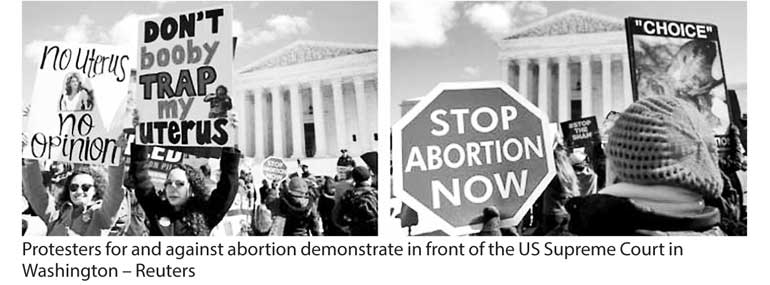Tuesday Mar 11, 2025
Tuesday Mar 11, 2025
Friday, 16 February 2018 00:00 - - {{hitsCtrl.values.hits}}
 By Nadeesh Jayasinghe
By Nadeesh Jayasinghe
It is estimated that over 600 illegal abortions take place in Sri Lanka every day (Suranga et al., 2017) while 90% of them involve married women. This staggering number shows that even though abortion is banned, people will still seek unregulated means of getting it done. Unregulated abortions are very dangerous and they are one of the largest causes of maternal deaths in Sri Lanka (UNFPA, 2012).
The proposed amendment to the existing law argues for a woman’s right to choose a safe, legal abortion for pregnancies resulting from rape and incest, if the woman is under the age of 16, or if the foetus has serious congenital malformation. However, the bill has sparked a variety of discussions on the ethical dimensions of abortion, the most aggressive of these within the Catholic Church in Sri Lanka.
In Catholic countries around the world, there have been different responses to the ‘abortion problem.’ This article discusses abortion in a global context, with specific focus on Catholic countries.
Chile and Uruguay were amongst the seven countries in Latin America to have banned abortion entirely (Guttmacher Institute, 2017). In 2017, however, legislation in Chile was passed to allow abortion under the circumstances where the life of the woman is in danger, the foetus is unviable, and when a pregnancy is the result of rape.
Although the Roman Catholic Church has significant influence over the socio-political direction of the country, around 70% of Chileans were in favour of the decision to ease the abortion ban (Kozak, 2017).
Similarly, Uruguay recently chose to look at abortion as a public health issue rather that a moral one. For years, unsafe abortion had been the leading cause of maternal mortality in the country. To address this, medical professionals and civil society groups worked together to implement a harm reduction approach which included “counselling women who were considering having abortions and then providing comprehensive post-abortion care” (Chung, 2016).
These steps lead to the drastic decrease in maternal mortality and now Uruguay has made safe abortion widely available in the first 12 weeks (14 weeks in the case of rape).
In 2012, Parliament passed a law to decriminalise abortion in the first trimester, with certain procedural requirements (Human Rights Watch, 2012).
In Ireland, the Opposition Leader, who was once a strong supporter of anti-abortion had a change in heart after hearing from the many experiences of women who had travelled great distances to end their pregnancies; who took abortion pills without medical guidance, and those who have exercised various other forms of unsafe abortion.
This change in attitude has opened the doors for an abortion referendum (planned for May, 2018) to repeal the 8th Amendment of Ireland’s Constitution which gives equal right to life to the woman and the foetus.
As can be seen, the response to abortion policy is diverse, especially amongst countries of Catholic influence. Many Catholics around the world have rejected the Church’s stance on contraception and abortion. Countries such as Chile, Uruguay, and Ireland have shifted away from looking at abortion as a moral issue to a health and rights issue.
Similarly, Sri Lanka should also look at abortion through a health and rights lens while being sensitive to the existing local realities (post-war trauma, high maternal death, high rape rates, socio-economics, etc.) in order to formulate its own response to it.
For a nuanced discussion on the legal, medical and theological perspectives on abortion and the right to choose, please join us for a forum that will be held on Tuesday, 27 February, 5.30 p.m. – 7.30 p.m. at the Centre for Society and Religion, 281 Dean’s Road, Maradana.
Sources:
Chung, C. (2016). How Uruguay Made It Easier to Have a Safe Abortion.
(online) Women and Girls. Available at: https://www.newsdeeply.com/womenandgirls/articles/2016/08/10/how-uruguay-made-it-easier-to-have-a-safe-abortion
Guttmacher Institute (2017). Abortion in Latin America and the Caribbean. (online) Available at: https://www.guttmacher.org/fact-sheet/abortion-latin-america-and-caribbean
Human Rights Watch (2012). Uruguay: New Abortion Law Breaks Ground for Women’s Rights. (online) Available at: https://www.hrw.org/news/2012/10/26/uruguay-new-abortion-law-breaks-ground-womens-rights
Kozak, P. (2017). ‘A triumph of reason’: Chile approves landmark bill to ease abortion ban. (online) The Guardian. Available at: https://www.theguardian.com/global-development/2017/aug/22/chile-abortion-bill-michelle-bachelet-a-triumph-of-reason-ease-abortion-ban
O’Toole, E. (2018). At last, an abortion referendum. Women’s protest has won over Irish politicians. (online) The Guardian. Available at: https://www.theguardian.com/commentisfree/2018/jan/30/abortion-referendum-ireland-women-protest-politicians-leo-varadkar-micheal-martin-repeal-mov
Smith, L. (2018). Everything you need to know about Ireland’s abortion referendum. (online) The Independent. Available at: http://www.independent.co.uk/news/world/europe/ireland-abortion-latest-updates-when-date-what-question-irish-voter-binding-catholic-church-leo-a8185511.html
Suranga, S., Silva, K. and Senanayake, L. (2017). Access to information and attitudes towards induced abortion: a community-based study among adults in the city of Colombo, Sri Lanka. Journal of the College of Community Physicians of Sri Lanka, 23(1), p.28.
United Nations Population Fund (2012). Population Situation Analysis. Available at: http://www.unfpa.org/sites/default/files/admin-resource/Sri-Lanka-Population-Situation-Analysis_0.pdf
Discover Kapruka, the leading online shopping platform in Sri Lanka, where you can conveniently send Gifts and Flowers to your loved ones for any event including Valentine ’s Day. Explore a wide range of popular Shopping Categories on Kapruka, including Toys, Groceries, Electronics, Birthday Cakes, Fruits, Chocolates, Flower Bouquets, Clothing, Watches, Lingerie, Gift Sets and Jewellery. Also if you’re interested in selling with Kapruka, Partner Central by Kapruka is the best solution to start with. Moreover, through Kapruka Global Shop, you can also enjoy the convenience of purchasing products from renowned platforms like Amazon and eBay and have them delivered to Sri Lanka.
Discover Kapruka, the leading online shopping platform in Sri Lanka, where you can conveniently send Gifts and Flowers to your loved ones for any event including Valentine ’s Day. Explore a wide range of popular Shopping Categories on Kapruka, including Toys, Groceries, Electronics, Birthday Cakes, Fruits, Chocolates, Flower Bouquets, Clothing, Watches, Lingerie, Gift Sets and Jewellery. Also if you’re interested in selling with Kapruka, Partner Central by Kapruka is the best solution to start with. Moreover, through Kapruka Global Shop, you can also enjoy the convenience of purchasing products from renowned platforms like Amazon and eBay and have them delivered to Sri Lanka.